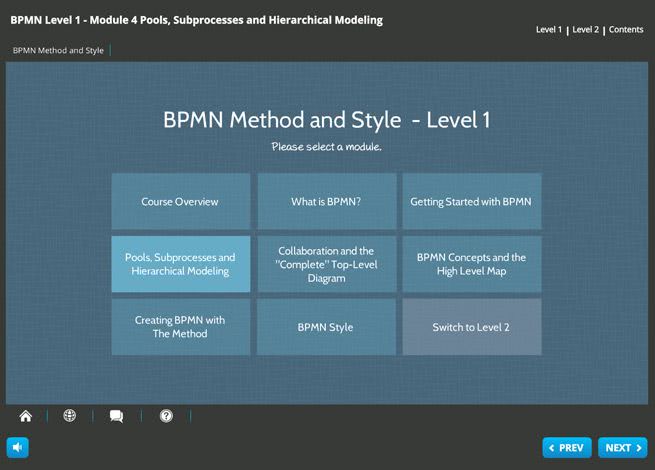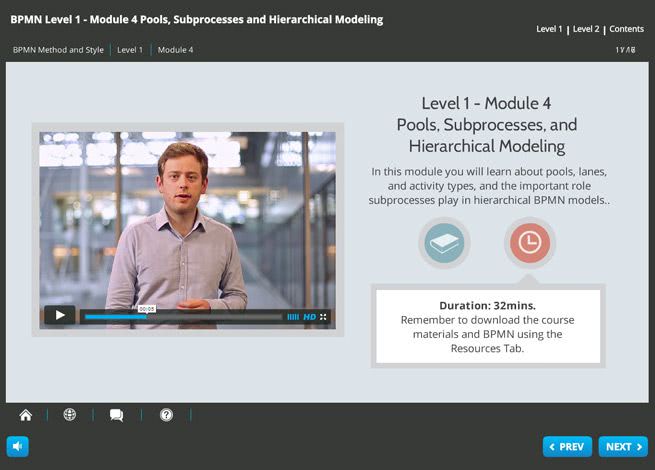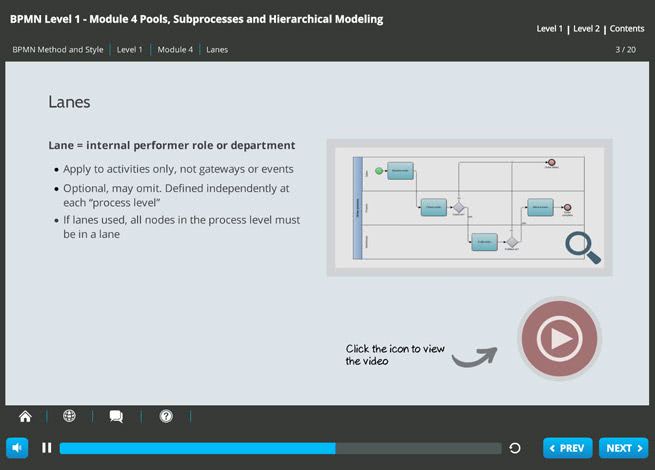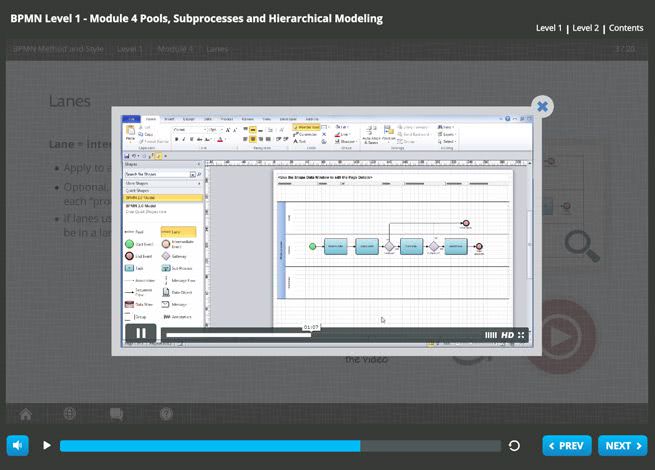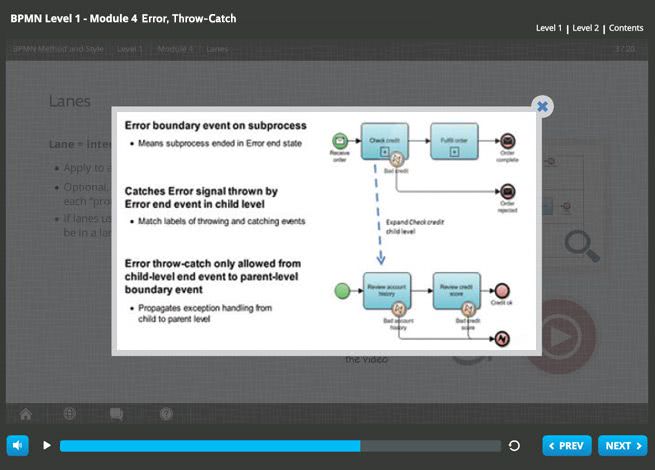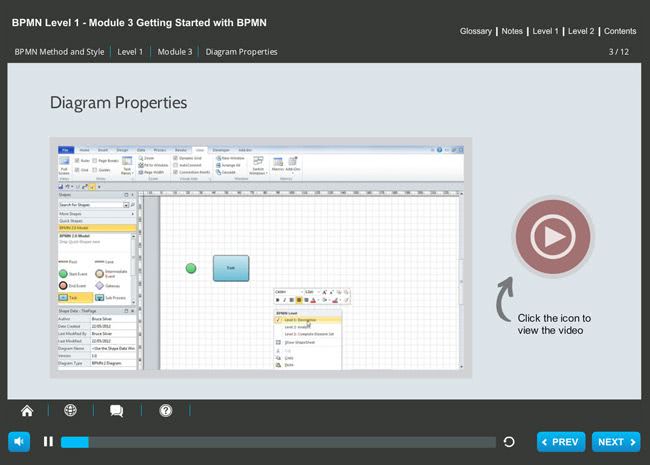BPMN 2.0 Foundation & Practitioner
(level 1 & 2)
6 months e-learning + Certificate of completion
€379 + VAT
(level 1 & 2)
“If it does not make at least three people angry – it is not a process.”
― Michael Hammer
BPMN 2.0 Foundation & Practitioner
(level 1 & 2)
E-learning + Certificate of completion
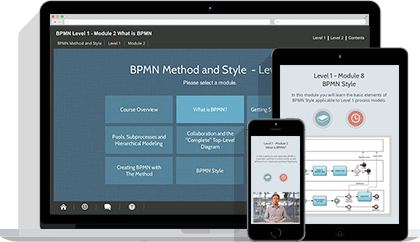
Key information about this course:
Price: 379 € + VAT ( 6 month E-learning)
- 7+ hours of course material
- Created by the leading BPMN 2.0. Author
- Expert tutor support
- Quizzes and revision modules
- 6 months access – start today!
Kick-start your Business Process Model and Notation (BPMN) training today by taking this extensive BPMN 2.0 course!
Created by experienced industry experts, this course will show you how to confidently map consistent and logical organizational processes in line with version 2.0 of the BPMN global standard. This common modeling methodology will allow you to create diagrams that can be shared consistently across all business domains.
Course Syllabus: BPMN Level 1
Module 1: Course Overview
This course has been designed & written by leading BPMN training expert Bruce Silver to teach you everything you need to create precise BPMN process models that can be clearly understood and adopted by the wider business.
In this module you will get an overview of the course, the key objectives, and the Orbus BPMN modeling tool that you will use.
Module 2: What is BPMN?
In this module you’ll learn about what BPMN is, the ways in which it is similar to and different from traditional flowcharts, and why understanding BPMN has become the critical foundation skill required for anything you do in BPM.
Module 3: Getting Started with BPMN
In this module you will learn how to use the Orbus BPMN 2 Template to create simple BPMN diagrams that include tasks, gateways, and multiple end states.
Module 4: Pools, Sub-processes, and Hierarchical Modeling
In this module you will learn about collaboration, the message flows indicating interactions between the process and external entities such as the Customer, service providers, and other processes, essential to a complete process model.
In addition you will learn the rest of the shapes and symbols in the BPMN Level 1 palette.
Module 5: Collaboration and a “Complete” Top-Level Diagram
In this module you will learn about collaboration, the message flows indicating interactions between the process and external entities such as the Customer, service providers, and other processes, essential to a complete process model.
In addition you will learn the rest of the shapes and symbols in the BPMN Level 1 palette.
Module 6: BPMN Concepts and the High Level Map
In this module you will understand the precise meaning of BPMN’s most fundamental concepts and why they are critical to properly structured models.
You will apply them in the first two steps of the Method, Scoping the Process and the High-Level Map.
Module 7: Creating BPMN with The Method
In this module you will translate the High Level Map into a top-level BPMN diagram, and then expand each High Level Map activity in a separate child-level diagram.
You will also learn how to add message flows to the model, replicating the collaboration from child to parent level.
Module 8: BPMN Style
In this module you will learn the basic elements of BPMN Style applicable to Level 1 process models.
Course Syllabus: BPMN Level 2
Module 1: Events Overview and Using Timer Events
In this module you will learn about the various ways in which BPMN uses intermediate events, the important events you need to learn, and how to use the first of the “Big 3” event types, Timer.
Module 2: Sending, Receiving, and Using Message Events
In this module you will learn about sending and receiving messages in BPMN and the proper use of Message events.
Module 3: Using Error, Event Sub-processes, and the Other Level 2 Events
In this module you will learn how to use the Error event, and understand event sub-processes and the other Level 2 event types.
Module 4: Branching and Merging
In this module you will learn more about branching and merging with gateways and conditional sequence flows.
Module 5: Iteration
In this module you will learn how to use loop and multi-instance activities and multi-pool structures to describe iterative behavior in BPMN.
Module 6: Following the Rules, and Next Steps
In this module you will learn about the BPMN metamodel, XML, and rules, and the importance of model validation, along with suggestions for further learning.
This eLearning course will teach you everything you need to create precise BPMN process models that can be clearly understood and adopted by your wider business. Our course has been designed & written by leading BPMN training experts.
You can practice your skills with prescribed “in-class” exercises using the Orbus Software BPMN 2.0 Visio template.
Each module concludes with a brief knowledge check to help students consolidate what they have learned. The questions are a combination of true or false, complete the sentence, sorting exercises and the occasional scenario.
Feedback is given with each answer to help the learner work through the topics. Students can also enjoy 24/7 tutor support.
Although there is no official examination or assessment, you will receive a certificate of completion once you successfully finish this course.

